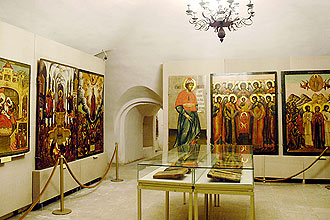 |
Christianity was brought to old Rus from Byzantium in 988. As the new religion spread, examples of mosaics and frescoes depicting the saints began to appear. The works were executed on wood using tempera - paints made from a mix of mineral colours, egg yolk and water, and then varnished. If the work was spoiled, then the artist would usually simply paint a new icon on top of the old.
During the last century, interest began in the restoration of ancient icons, and many of these ancient masterpieces were discovered under layers of dirt and later paint. Surprisingly, they were very well preserved. Icons were usually encased in rich frames of gold or silver, encrusted with precious stones. The most important quality for an icon was its ability to transmit a feeling of ecstasy and heavenliness. To attain these aesthetic goals, the painters used established techniques: the images of the saints were executed in a particular range of colours, and always appeared to be flat.
Few of the names of these ancient craftsmen have survived to this day but, undoubtedly, one of the most famous and talented icon painters was Andrei Rublev, celebrated in Tarkovsky's famous film, in whose honour the Museum of Ancient Russian Art is named. Andrei Rublev lived and worked as a monk in the St Andronicus Monastery, and is also buried here.
|
 |

 This unique museum is the resting place for some of the most precious examples of Russian Orthodox art.
This unique museum is the resting place for some of the most precious examples of Russian Orthodox art.